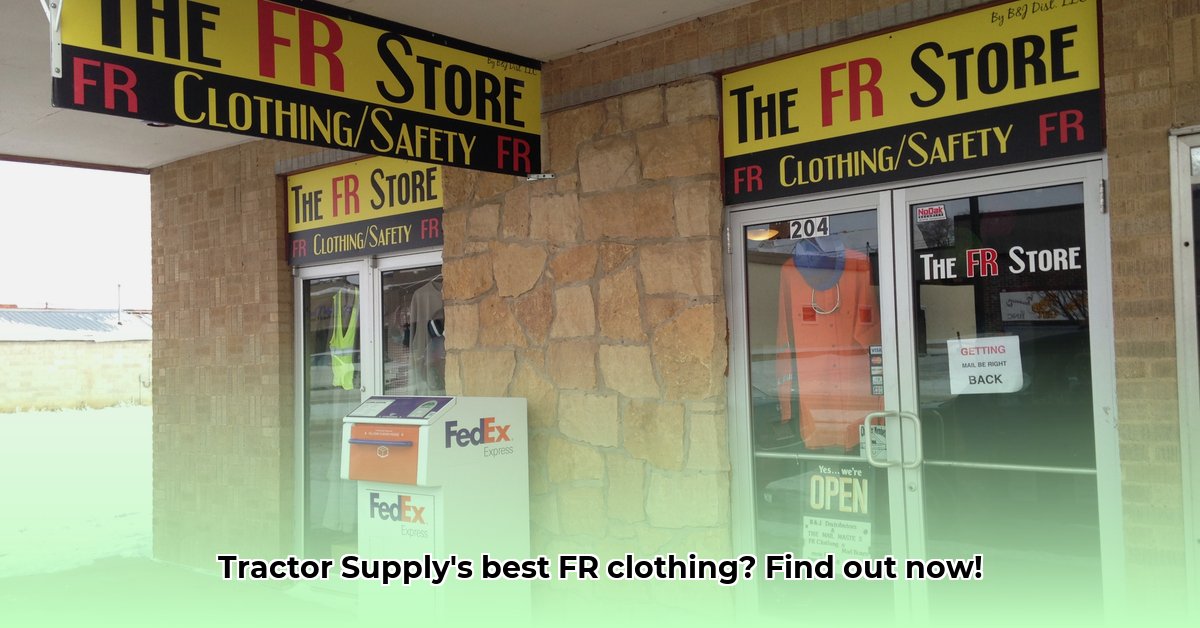
Working on a farm or ranch exposes you to significant fire risks. Flame-resistant (FR) clothing is your first line of defense, but choosing the right gear involves more than just safety; it's about sustainability too. This guide helps you navigate the options at Tractor Supply, balancing protection with eco-conscious choices. For more information on Tractor Supply products, visit Tractor Supply here.
Choosing the Right FR Clothing Material
The fabric of your FR clothing is paramount. Tractor Supply offers various materials, each with unique properties and environmental impacts.
- Cotton: Comfortable and breathable, but often treated with chemicals to achieve FR properties, raising sustainability concerns. Look for organic cotton certifications for a more eco-friendly option.
- Synthetic Blends: Often a balance of comfort and durability, offering a good compromise. However, the exact composition and manufacturing processes are critical to evaluating their sustainability. Check for recycled content.
- Synthetics (e.g., Nomex, Kevlar): Highly durable and inherently flame-resistant, meaning they don't require chemical treatments. However, their manufacturing process can have a significant environmental footprint. Consider lifecycle impacts.
Choosing the best material depends on your priorities – comfort, durability, cost, or sustainability. Each material presents trade-offs.
Durability, Care, and Cost: A Long-Term Perspective
Don't just focus on the initial price. A more expensive, durable garment that lasts longer is ultimately more cost-effective and environmentally friendly than frequently replacing cheaper options.
Proper care is essential. Always follow the manufacturer's washing instructions. Some FR clothing requires special detergents or hand-washing to maintain its fire-resistant properties. Neglecting these instructions can compromise safety and shorten the garment's lifespan.
Consider the cost per wear. A higher upfront cost might translate to lower long-term expenses and less waste.
Sustainability: Making Eco-Conscious Choices
Look for certifications like "organic cotton" or labels indicating recycled materials. These signify a commitment to sustainable production practices. However, comprehensive labeling across all FR clothing at Tractor Supply is currently lacking, making completely informed, sustainable choices challenging. Transparency improvements are needed in this sector.
Disposal and Recycling: Responsible End-of-Life Management
Don't simply throw away old FR clothing. These garments often contain treatments with environmental consequences if landfilled. Investigate local textile recycling programs that accept flame-resistant materials. Your local waste management department can provide guidance on responsible disposal methods.
Beyond FR Clothing: A Multi-Layered Approach to Safety
While FR clothing is crucial, it's not a standalone solution. Supplement it with other safety measures:
- Regular Equipment Maintenance: Preventative maintenance reduces the risk of equipment malfunctions that could lead to fires.
- Readily Available Fire Extinguishers: Ensure easy access to fire suppression equipment.
- Thorough Safety Training: Proper training empowers workers to identify and mitigate fire hazards.
A comprehensive safety plan integrates various protective measures for maximum effectiveness.
Choosing Your FR Clothing: A Step-by-Step Guide
- Assess Your Risks: Identify specific fire hazards your work involves to determine the necessary level of protection.
- Select Your Material: Consider comfort, durability, cost-per-wear, and sustainability certifications. Weigh the trade-offs within your budget.
- Prioritize Durability: A longer-lasting garment minimizes waste and saves you money in the long run.
- Follow Care Instructions: Adhere to the manufacturer's instructions to maintain the garment's fire resistance and extend its life.
- Seek Sustainable Options: Look for eco-friendly certifications or labels, understanding the limitations in current industry transparency.
- Plan for Responsible Disposal: Locate local recycling options before you need them.
- Implement a Holistic Safety Plan: Remember, FR clothing is one component of a larger safety strategy.
Material Comparison: A Quick Reference
| Material | Pros | Cons | Sustainability Considerations |
|---|---|---|---|
| Cotton | Comfortable, breathable | Requires chemical treatments, less durable | Look for organic certifications and low-impact treatments |
| Synthetic Blends | Durable, often cost-effective | Less breathable than cotton, may contain synthetics | Check for recycled content and manufacturing processes |
| Synthetics | High durability, inherently flame resistant | Less comfortable than cotton, manufacturing impacts | Evaluate manufacturing processes and look for certifications |
By carefully considering material, durability, cost, and sustainability, you can choose FR clothing that protects you and minimizes your environmental impact. Remember, it's about finding the right balance – powerful protection paired with responsible choices.